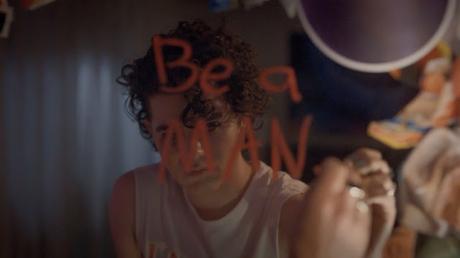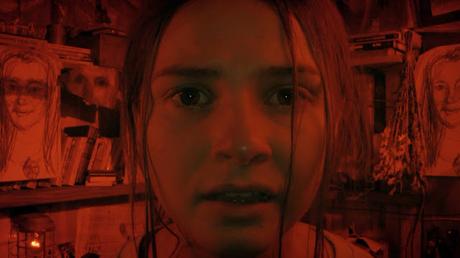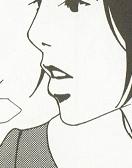Deep in the woods, there lies a secret door. And behind it, nightmares. Real nightmares.
A girl runs away from a community hidden deep in the woods of Oregon and arrives in the small dying mining town West Pine. Everyone knows where she is from – a cult, from their perspective, that insists on linen clothes, lives without technology, incomprehensible rituals. She is ridiculed until a local helps her, gives her more appropriate clothes, promises her to help her to get to Salem. But then, things become weird: monsters appear, and wreak havoc until the girl – Casey (Stefanie Scott) – reveals herself to have been trained to hunt and banish these creatures.

The Girl in the Woods is a marvel. At less than thirty minutes per episode and only eight episodes in its first season, it maps out the characters and a whole mythology that could last it for years. Krysten Ritter (Jessica Jones herself) executive produces and directs half the episodes. The three central characters are all teenagers stuck in their own version of hell – Carrie (Stefanie Scott, who looks distractingly like a young Jill Hennessy) most literally inside the cult, but Tasha (Sofia Bryant, I’m Not Okay With This) and especially Nolan (Misha Osherovich, NOS4A2) struggle with the closed-mindedness of their small town, with the fact that their respective families are stuck in a place that is economically dying and experiencing a profound rift between those dependent on the closing mine and those who wish to close it for health and environmental reasons. They are both too different to fit in, Tasha as an artist who tries to reach the outer world with videos, but never gains enough traction to see it as a way out, and Nolan as someone who is in the process of realising their gender identity in a town so dominated by toxic masculinity. There is plenty of violence in West Pine even before the monsters begin appearing, and most of it is directed at Nolan, at their refusal to fit in with the other men in town – there is physical, obvious violence perpetrated by other teenagers, but also a more oblique, subtle violence that they experience from their own father, an inability to conceptualise Nolan who refuses to fit into any tight corset of identity.
Carrie’s cult, the Disciples of Dawn, are like a more eloquently thought-through version of Buffy’s Watchers. Imagine if the fate of the world was laid on the shoulders of a teenager, who was honed for that task through trials of psychological and physical violence, isolated from the rest of the world and twisted so brutally away from human connection that she would, in the end, betray the girl she loves (Sara, played by Kylie Liya Page) to make her elders happy? Their entire ideology rests on the idea that a devotion to a higher cause overrides any right to freedom and happiness. The cult is led by Hosea (Reed Diamond, Dollhouse), who reveals himself to be more pragmatic than expected when he needs to adjust the ideology to embrace Carrie’s actions, but still makes for a horrifying figure, a father who demands and leads through violence.
Once she escapes, she finds a world she could have never imagined – one in which individual happiness often shockingly trumps all other concerns (in the end, Tasha’s obsession with posting everything online is what gives Carrie’s location away to those who seek her), but also one in which there is the freedom to express emotions, to make connections that are based on empathy rather than competition and ruthlessness. Carrie learns about this world through her relationship with Tasha and Nolan, through realising what their complex emotions for each other are – early on, Tasha reveals that she likes Nolan, but feels rejected by them, and then Nolan shares with her that they find it hard to approach a relationship with all the baggage of masculinity attached, a label that doesn’t fit them at all, that they abhor without really knowing yet how to escape its demands (it’s one of the most layered conversation I’ve seen about being non-binary on television). Later the same day, at a bonfire party, Tasha asks Carrie to slow-dance with her, something Carrie has never done before – most of her previous physical experiences are with fighting, being asked to beat or be beat up by Sara, in their bids to become the chosen ones – and in an example of misplaced emotions, they end up kissing (one of Tasha’s defining features is her openness, both emotionally and intellectually), which Nolan observes just before they get severely beaten up by the town bully, who resents Nolan’s mine-opposing parents. Later, in a brutal reunion with Sara, Carrie longingly says she wishes that it had been her instead, a proposition that remains impossible and out of reach because Sara is still firmly in the grasp of the cult.
 And in the world of The Girl in the Woods, toxic masculinity becomes a literal monstrosity. Asked by their father to just “man up”, to develop a thick skin, instead of holding Nolan’s bullies accountable for their actions or taking any steps to protect his child from further violence, Nolan writes “Be a Man.” On a mirror, only to then transform into an actual monster from a parasite. In this monstrous town, the only response is more violence, and Nolan, no longer themselves, begins tearing the town and its bullies apart. Their friends have to find a way to save both the town and Nolan, and the finale ends in a cliffhanger that I dearly hope will be resolved one day.
And in the world of The Girl in the Woods, toxic masculinity becomes a literal monstrosity. Asked by their father to just “man up”, to develop a thick skin, instead of holding Nolan’s bullies accountable for their actions or taking any steps to protect his child from further violence, Nolan writes “Be a Man.” On a mirror, only to then transform into an actual monster from a parasite. In this monstrous town, the only response is more violence, and Nolan, no longer themselves, begins tearing the town and its bullies apart. Their friends have to find a way to save both the town and Nolan, and the finale ends in a cliffhanger that I dearly hope will be resolved one day. 2021-, created by Felicia Ho and J. Casey Modderno, starring Stefanie Scott, Sofia Bryant, Misha Osherovich, Reed Diamond, Will Yun Lee, Kylie Liya Page, Leonard Roberts.


